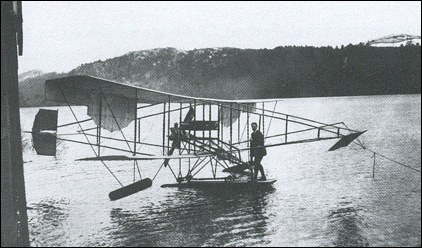|
| There is no text information for this aircraft at the moment.
| Terrence I. Murphy, e-mail, 10.02.2012 19:00 The Lakes Waterbird is remembered as the first consistently successful British seaplane, developed by the Windemere based Lakes Flying Co, during 1911.
Avro built the aircraft in Manchester, transporting it to Brooklands for its first flight on 19th May 1911. It was a two-bay seat pusher biplane with wings of unequal span. The outer half of each upper wing carried a pair of ailerons; the larger inner one had a semicircular trailing edge extending well behind the wing trailing edge. Bamboo outriggers fore and aft of the wings supported leading elevators and tail surfaces plus rudder. Both elevator and rudder were operated by bamboo pushrods. Power was provided by a 50 hp (37 kW) Gnome 7-cylinder rotary engine driving an 8 ft 6in (2.59 m) propeller.
After testing as a landplane at Brooklands in May 1911, the Water Bird was brought to the Hill of Oaks on Windermere and the float fitted in place of the wheeled undercarriage. A pair of cylindrical floats was mounted below the wing-tips for lateral stability on the water. The successful first flight was on 25 November 1911, with ex-Avro school pilot H. Stanley Adams
Water Bird flew intensively during December 1911 and January 1912, logging some 60 flights. The longest was for 20 miles, reaching 800 ft. Joyriding passengers were carried through the Winter, but in March 1912 Water Bird was destroyed in its lakeside hangar by a storm.
General characteristics
Crew: 1
Capacity: 1
Length: 36 ft 5 in (11.10 m)
Wingspan: 41 ft 0 in (12.50 m)
Wing area: 365 ft2 (33.9 m2)
Empty weight: 780 lb (354 kg)
Gross weight: 1,130 lb (513 kg)
Powerplant: 1 Χ Gnome et Rhτne 7-cylinder rotary, 50 hp (37 kW)
Performance
Maximum speed: 45 mph (72 km /h)
Service ceiling: 800 ft (244 m) reply | | Terrence I. Murphy, e-mail, 10.02.2012 19:00 The Lakes Waterbird is remembered as the first consistently successful British seaplane, developed by the Windemere based Lakes Flying Co, during 1911.
Avro built the aircraft in Manchester, transporting it to Brooklands for its first flight on 19th May 1911. It was a two-bay seat pusher biplane with wings of unequal span. The outer half of each upper wing carried a pair of ailerons; the larger inner one had a semicircular trailing edge extending well behind the wing trailing edge. Bamboo outriggers fore and aft of the wings supported leading elevators and tail surfaces plus rudder. Both elevator and rudder were operated by bamboo pushrods. Power was provided by a 50 hp (37 kW) Gnome 7-cylinder rotary engine driving an 8 ft 6in (2.59 m) propeller.
After testing as a landplane at Brooklands in May 1911, the Water Bird was brought to the Hill of Oaks on Windermere and the float fitted in place of the wheeled undercarriage. A pair of cylindrical floats was mounted below the wing-tips for lateral stability on the water. The successful first flight was on 25 November 1911, with ex-Avro school pilot H. Stanley Adams
Water Bird flew intensively during December 1911 and January 1912, logging some 60 flights. The longest was for 20 miles, reaching 800 ft. Joyriding passengers were carried through the Winter, but in March 1912 Water Bird was destroyed in its lakeside hangar by a storm.
General characteristics
Crew: 1
Capacity: 1
Length: 36 ft 5 in (11.10 m)
Wingspan: 41 ft 0 in (12.50 m)
Wing area: 365 ft2 (33.9 m2)
Empty weight: 780 lb (354 kg)
Gross weight: 1,130 lb (513 kg)
Powerplant: 1 Χ Gnome et Rhτne 7-cylinder rotary, 50 hp (37 kW)
Performance
Maximum speed: 45 mph (72 km /h)
Service ceiling: 800 ft (244 m) reply |
|
Do you have any comments?
|
| |










e
reply